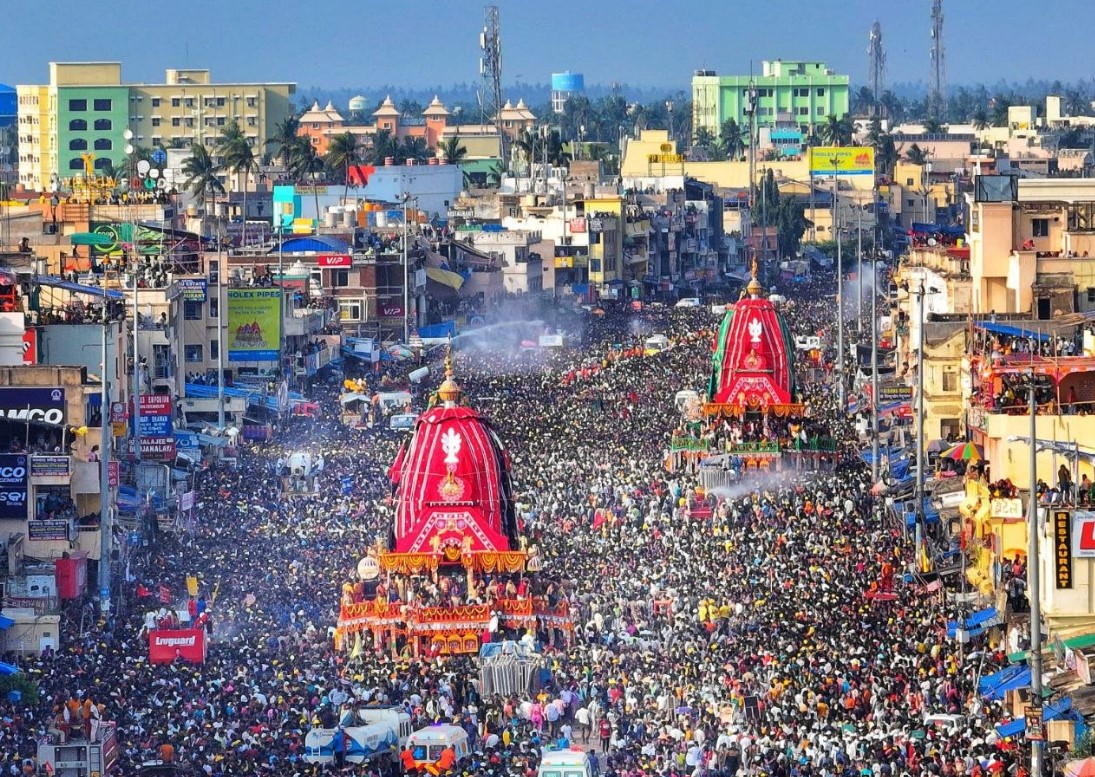By Nivi Shrivastava
In Odisha, the coastal city of Puri is famous for its flamboyant religious heritage for centuries. This June, the world-famous Puri Rath Yatra (also known as Gundicha Yatra) begins on June 20th, and the 600-yr-old ‘Festival Of Chariots’ is set to commence the divine journey of Lord Jagannath, Balabhadra & Subhadra. The Jagannath Rath Yatra is dedicated to Lord Jagannath, and lakhs of devotees from the state, as well as every part of the country, travel to the city of Puri, to catch a glimpse of the three deities, Lord Jagannath, Lord Balabhadra, and Devi Subhadra being carried in ornate chariots (made from neem wood) called Raths that are pulled by the devotees. The festival is believed to commemorate the deities’ annual visit to their aunt’s house.
The auspicious festival begins with the Snana Yatra where the three deities are washed thoroughly in Ganges water. The festival lasts for about nine days, during which various rituals and ceremonies are performed. After spending a week at the Gundicha Temple, the deities are brought back to the Jagannath Temple in a return procession known as the Bahuda Yatra. This is followed by the Anasara period where the deities are laid to ‘rest’.
Among the many interesting narratives that construct a grandiose silhouette of this royal temple town is the culture of Jagagharas. It is an exclusive ‘male only’ lifestyle that is believed to have originated during the 12th century for men, particularly bachelors, under the royal patronage to create a security force for the protection of the pilgrim town and Lord Jagannath’s temple. The concept of Jagagharas is similar to a cultural club where women are strictly forbidden, and young men gather to indulge in common baths, bodybuilding, wrestling, and musical performances along with frolic activities.
A Jagaghara is a place for men to rest and relax, play cards, Passa or Ganjapa while they prepare for bodybuilding competitions under the apex bodies called Akhadas. A temple, a nearby water tank (for bathing), and a wrestling arena with a group of members called Sangas (friends) are mandatory to form a Jagaghara. Usually, the temple dedicated to Lord Mahavir (Hanuman) is worshipped by the Sangas as he is considered to be the god for physical strength and celibacy. Some members also worship Goddess Durga in Jagaghar temples for courage. The strong, virtuous men are utilized by different temple committees for protecting the shrines from outsiders, and their contribution was quite significant during the attack of non-Hindu invaders on the pilgrimage.
Despite their popularity among residents, Jagaghars are usually away from the touristy limelight due to the secluded lifestyles of the men who practice martial arts and body-building in these places. The Jaga Akhada men usually practice the traditional style of wrestling and use Mudgara, a wooded gada (mallet) of different sizes to compete. The mud or clay bed for wrestling in a Jaga Akhada is known as Phulka and some musical instruments like Mardala are found in these Jagagharas. According to the traditional culture, Odissi song and Gotipua dance were practiced in the Jagas in ancient times. In the colloquial language, the members describe “Janga (wrestling together), Bhanga (consuming hemp), Sanga (friends), Sangeeta (music) and Pangata (feasting together)” as the quintessential of Jagaghar culture.
The Jagagharas of Puris are the birthplace of festivals and cultural processions, and the members are active participants in such activities. One of the most prominent tanks in Puri is called the Narendra Tank, where members of Jagaghars go to take a royal bath during the procession of Chandan Jatra. The procession is also known as Gandhalepana Yatra and starts from Akshaya Tritiya and continues for 21 days. This is the holy period when construction of the chariots for the annual Ratha Jatra of Lord Jagannath Temple takes place and deities are given a bath in sandalwood paste. During the festivities, the traditional weapons of Jagagharas are displayed to the public at the procession and the wrestlers showcase various martial forms with swords, fireballs, sticks, and knives to demonstrate their vigor. After this holy procession, the jagas proceed to the Jamunagadhua after Krushnajanma for Sahi Jatra, which begins from the Rama Navmi. The Sahi Jatra is a series of traditional street plays organized by different Jagagharas for the entertainment of the public, during which the members dress up as mythical gods and demons like Rama, Ravana, Parsuram, etc. and enact various religious stories in dramatic art forms for entertaining the devotees.
While the ancient Jagaghara were given names after Gadas or Kotas (which means forts in Sanskrit), there later ones were named after the patrons, who offered their lands to construct jagaghars. Some of the famous Jagas in Puri are Dhwajagada, Luhagada, Malligada, Kadambagada, Bajragada, Juigada, Jaigada, Champagada, Khakikota, Sankhakota, Nagakota, Marichikota, Jadukota, Bhatta Jaga, Jamai Khuntia Jaga, Rahas Mohanty Jaga, Adanga Tiadi Jaga, Badu Mohapatra Jaga and many more.


